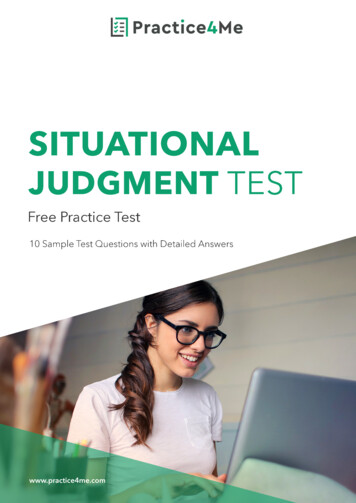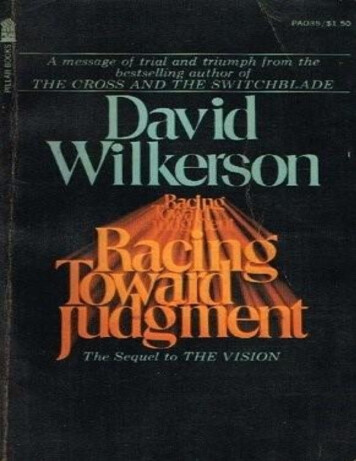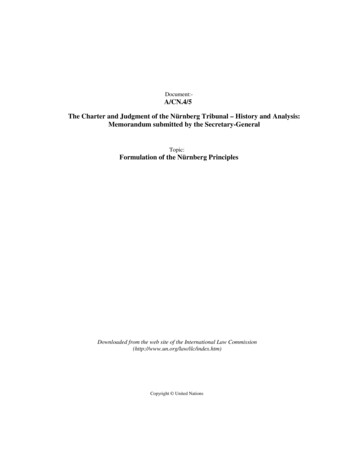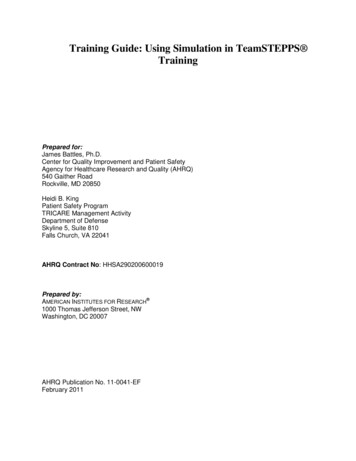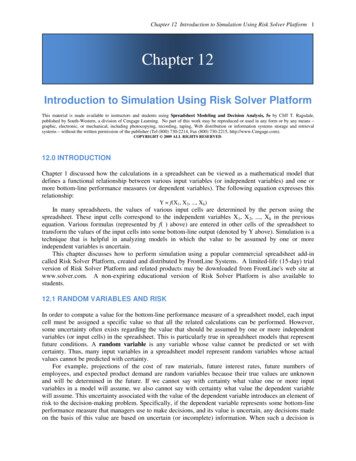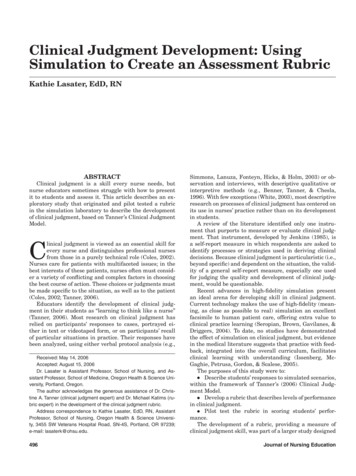
Transcription
Clinical Judgment Development: UsingSimulation to Create an Assessment RubricKathie Lasater, EdD, RNAbstractClinical judgment is a skill every nurse needs, butnurse educators sometimes struggle with how to presentit to students and assess it. This article describes an exploratory study that originated and pilot tested a rubricin the simulation laboratory to describe the developmentof clinical judgment, based on Tanner’s Clinical JudgmentModel.Clinical judgment is viewed as an essential skill forevery nurse and distinguishes professional nursesfrom those in a purely technical role (Coles, 2002).Nurses care for patients with multifaceted issues; in thebest interests of these patients, nurses often must consider a variety of conflicting and complex factors in choosingthe best course of action. These choices or judgments mustbe made specific to the situation, as well as to the patient(Coles, 2002; Tanner, 2006).Educators identify the development of clinical judgment in their students as “learning to think like a nurse”(Tanner, 2006). Most research on clinical judgment hasrelied on participants’ responses to cases, portrayed either in text or videotaped form, or on participants’ recallof particular situations in practice. Their responses havebeen analyzed, using either verbal protocol analysis (e.g.,Received: May 14, 2006Accepted: August 15, 2006Dr. Lasater is Assistant Professor, School of Nursing, and Assistant Professor, School of Medicine, Oregon Health & Science University, Portland, Oregon.The author acknowledges the generous assistance of Dr. Christine A. Tanner (clinical judgment expert) and Dr. Michael Katims (rubric expert) in the development of the clinical judgment rubric.Address correspondence to Kathie Lasater, EdD, RN, AssistantProfessor, School of Nursing, Oregon Health & Science University, 3455 SW Veterans Hospital Road, SN-4S, Portland, OR 97239;e-mail: lasaterk@ohsu.edu.496Simmons, Lanuza, Fonteyn, Hicks, & Holm, 2003) or observation and interviews, with descriptive qualitative orinterpretive methods (e.g., Benner, Tanner, & Chesla,1996). With few exceptions (White, 2003), most descriptiveresearch on processes of clinical judgment has centered onits use in nurses’ practice rather than on its developmentin students.A review of the literature identified only one instrument that purports to measure or evaluate clinical judgment. That instrument, developed by Jenkins (1985), isa self-report measure in which respondents are asked toidentify processes or strategies used in deriving clinicaldecisions. Because clinical judgment is particularistic (i.e.,beyond specific) and dependent on the situation, the validity of a general self-report measure, especially one usedfor judging the quality and development of clinical judgment, would be questionable.Recent advances in high-fidelity simulation presentan ideal arena for developing skill in clinical judgment.Current technology makes the use of high-fidelity (meaning, as close as possible to real) simulation an excellentfacsimile to human patient care, offering extra value toclinical practice learning (Seropian, Brown, Gavilanes, &Driggers, 2004). To date, no studies have demonstratedthe effect of simulation on clinical judgment, but evidencein the medical literature suggests that practice with feedback, integrated into the overall curriculum, facilitatesclinical learning with understanding (Issenberg, McGaghie, Petrusa, Gordon, & Scalese, 2005).The purposes of this study were to:l Describe students’ responses to simulated scenarios,within the framework of Tanner’s (2006) Clinical Judgment Model.l Develop a rubric that describes levels of performancein clinical judgment.l Pilot test the rubric in scoring students’ performance.The development of a rubric, providing a measure ofclinical judgment skill, was part of a larger study designedJournal of Nursing Education
lasaterto explore the effects ofsimulation on student aptitude, experience, confidence, and skill in clinicaljudgment (Lasater, 2005).Literature ReviewWhy a Rubric?A rubric, by its most basic definition, is an assessment tool that delineatesthe expectations for a taskor assignment (Stevens& Levi, 2005). By clearlydescribing the conceptand evidence of its understanding, students andfaculty are more likely torecognize it when students Figure. Clinical Judgment Model.perform it. In addition, Reprinted with permission from SLACK Incorporated. Tanner, C.A. (2006). Thinking like a nurse: A researchrubrics facilitate commu- based model of clinical judgment in nursing. Journal of Nursing Education, 45(6), 204-211.nication among studentsand provide students, preceptors, and faculty with language to foster both feedbackand defines stages or levels in the development of clinicaland discussion.judgment. The Figure illustrates Tanner’s model.In addition, communication cultivates critical thinkThe four phases of the model—Noticing, Interpreting, Reing. By having expectations or stages of development desponding, and Reflecting—describe the major components ofscribed and known by nursing students, preceptors, andclinical judgment in complex patient care situations that infaculty, the depth of discussion, based on individual pervolve changes in status and uncertainty about the approprispectives about clinical judgment, increases. Stevens andate course of action. The overall concepts or actions may beLevi (2005) pointed out that with the language providedsummarized as the thinking-in-action skills of three steps:by rubrics and the improved communication that results,noticing, interpreting, and responding (during the situationfaculty may also have additional evidence with which tothat requires clinical judgment), followed by the fourth step,enhance their teaching.the thinking-on-action skills of reflection after responding toLastly, rubrics can provide a more level playing fieldthe situation (Cotton, 2001; Schön, 1987).for increasingly diverse groups of students. It is no secretIn other words, the nurse must be cognizant of the pathat higher education, including nursing, is enjoying andtient’s need through data or evidence, prioritize and makeis challenged by greater diversity of students related tosense of the data surrounding the event, and come to somecharacteristics such as ethnicity, gender, and experienceconclusion about the best course of action and respond to(Abrums & Leppa, 1996; Brady & Sherrod, 2003; Domthe event. The outcomes of the action selected provide therose, 2003; Kuh, 2001). Although this diversity enrichesbasis for the nurse’s reflection afterward on the approprithe education experience of all involved, the possibilityateness of the response and clinical learning for futureof misunderstanding or lack of clarity about expectationspractice.may increase. Rubrics can serve as “translation devices inAccording to Tanner’s model, the nurse’s perceptionthis new environment” (Stevens & Levi, 2005, p. 27).of any situation is influenced by the context and stronglyshaped by the nurse’s practical experience; it is also rootedClinical Judgmentin the nurse’s theoretical knowledge, ethical perspectives,This study used a definition of clinical judgment deand relationship with the patient. This frame allows forscribed by Benner et al. (1996): “Clinical judgment referssome unique differences in the ways nurses may notice pato the ways in which nurses come to understand the probtient situations to set the cycle in motion. The model alsolems, issues, or concerns of clients/patients, to attend toproffers that clinical judgment is demonstrated through asalient information and to respond in concerned and invariety of reasoning processes, including analytic, whichvolved ways” (p. 2). Tanner (1998, 2006) conducted a comis predominant with students; intuitive, which is basedprehensive review of the research literature and developedin practical experience (Coles, 2002; Tanner, 2006) anda Clinical Judgment Model, derived from a synthesis ofwhich students generally lack; and narrative, or the learnthat literature. The model (Tanner, 2006) was the conceping that occurs from nurses and students telling their stotual framework used to develop a rubric that breaks downries (Tanner, 2006).November 2007, Vol. 46, No. 11497
clinical judgment rubricSampleStudents enrolled asthird-term juniors in anStudy Time Frame for Observations (Qualitative)adult medical-surgical clinWeek of StudyRubric Development PhaseNumber of Observationsical course were the studyWeek nts; consent wasobtained during the firstWeek 2Observation-revision-review-description4week of the term. QualitaWeek 3Observation-revision-review-description6tive observations (n 53)Week 4Observation-scoring-revision-review13of 39 third-year studentsin the simulation laboraWeek 5Observation-scoring-revision-review14tory during a 7-week studyWeek 6Observation-revision-review4time frame were used toWeek 7Observation-revision-review7develop and refine a quanTotal53titative instrument, theLasater Clinical JudgmentRubric (LCJR). At the endIt should be noted that reflection is the catalyst for clinof the study time frame, aical learning (Tanner, 2006). Early in educational researchfocus group of 8 of the observed students was convened toand theory development, Dewey (1933) made the profoundfurther test the findings.observation that “reflective thought alone is educative” (p.2). Others later concurred (Boud, 1999; Boud & Walker,Procedure1998), allowing that reflection gives learners the opporA 4-year baccalaureate nursing program, with studentstunity to sort out their learning through an exploratorytaking clinical courses in the last 2 years of the program,process. Tanner’s (2006) Clinical Judgment Model stronginitiated simulation as an integral part of the curriculum.ly links one of the outcomes of clinical judgment—clinicalTwo groups of 12 students each came to the laboratory, alearning—to the nurse’s background, implying that thehospital-like room containing a computerized human panurse is continually learning and developing with eachtient simulator, on one of two mornings per week, in lieupatient encounter. In this way, reflecting on clinical judgof their clinical practicum. Each group of 12 students enments fosters development and expertise.gaged in the activity for 2½ hours, for a total of 48 studentsduring the 2 days. Within each group of 12, four patientMethodcare teams of 3 students each participated in a scenarioat each session. While each patient care team engaged inDesignthe scenario, 9 students were able to watch the simultaneThis part of the larger study used a qualitative-quantious action from the debriefing room. In each patient caretative-qualitative design, typical for exploratory researchteam, 1 student served as primary nurse with ultimate(Cresswell, 2003). A cycle of theory-driven description-obserresponsibility for the patient care interventions, includingvation-revision-review was the design method used for thisdelegation to team members.study. Initially, the descriptive statements, using the anchorsThe goal of the activity was for each student to haveof best and worst performance descriptors were written forequal opportunity to be the primary nurse for the complexeach of the four phases—noticing, interpreting, responding,patient care scenarios. Throughout the term, each team’sand reflecting. This was followed by 3 weeks of observations,position during the sessions rotated, as did the primaryduring which the descriptions of the four phases were craftednurse role, so all groups had equal opportunity to be theinto dimensions that further explained the four phases. Also,first group and the last and so each student was able tothe four stages of development or levels—beginning, develbe the primary nurse. Therefore, each patient care teamoping, accomplished, and exemplary—were defined. Ongoengaged in a scenario weekly; every third week, a studenting observations throughout the study provided opportuniwas the primary nurse. Verbal feedback and discussionties for revisions of the descriptions of both the dimensionswere provided, but the simulation experiences were notand levels. In addition, the revisions and data were reviewedgraded.week by week with an expert in rubric development and anEach simulation experience included two phases andexpert in clinical judgment. Comments returned from thesethree opportunities for learning, as described by Seropiexperts were added and tested.an et al. (2004). In the first phase, the actual simulation,The description-observation-revision-review cycle wasthe students directly involved benefited from interactingrepeated weekly for 3 weeks until the rubric was developedwith a contextual patient scenario. At the same time, theenough to pilot test the scoring of student performancesother students could observe the live action. During theduring Weeks 4 and 5. Weeks 6 and 7 allowed for continuedsecond phase, or debriefing, both groups learned by critiobservation and further refinement of the rubric. Table 1cally thinking about and discussing the experience. Bothshows the week-by-week study time frame and purpose.phases were videotaped for this study.Table 1498Journal of Nursing Education
lasaterObservations (Qualitative)Before the observations began, the simulation facilitator and the researcher, both experienced clinical faculty,wrote descriptions of the best and worst student behaviorsfor each of the model’s four phases, which helped form theinitial dimensions of each phase and the descriptions ofeach dimension at the highest and lowest levels.The observations began with the specific focus on students’ reasoning and knowledge abilities in the primarynurse role, looking for evidence of the student’s noticing,interpreting, responding, and reflecting. The initial LCJRscoring sheet contained space for the observer’s field notesin each of the four phases of the model. At the end of eachweek’s observatio
CLINICAL JuDGMENT RuBRIC It should be noted that reflection is the catalyst for clin-ical learning (Tanner, 2006). Early in educational research and theory development, Dewey (1933) made the profound observation that “reflective thought alone is educative” (p. 2). Others later concurred (Boud, 1999; Boud &

